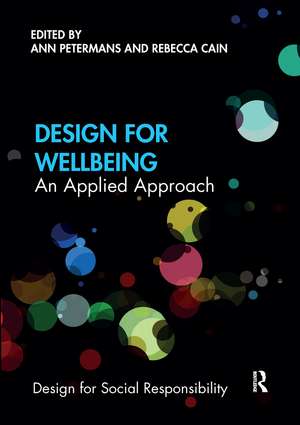Design for Wellbeing: An Applied Approach: Design for Social Responsibility
Editat de Ann Petermans, Rebecca Cainen Limba Engleză Paperback – 30 sep 2021
| Toate formatele și edițiile | Preț | Express |
|---|---|---|
| Paperback (1) | 258.29 lei 3-5 săpt. | +21.28 lei 4-10 zile |
| Taylor & Francis – 30 sep 2021 | 258.29 lei 3-5 săpt. | +21.28 lei 4-10 zile |
| Hardback (1) | 764.20 lei 6-8 săpt. | |
| Taylor & Francis – 20 noi 2019 | 764.20 lei 6-8 săpt. |
Preț: 258.29 lei
Nou
49.43€ • 53.67$ • 41.52£
Carte disponibilă
Livrare economică 01-15 aprilie
Livrare express 15-21 martie pentru 31.27 lei
Specificații
ISBN-10: 1032176520
Pagini: 248
Ilustrații: 56 Illustrations, black and white
Dimensiuni: 174 x 246 x 19 mm
Greutate: 0.42 kg
Ediția:1
Editura: Taylor & Francis
Colecția Routledge
Seria Design for Social Responsibility
Locul publicării:Oxford, United Kingdom
Public țintă
Professional Practice & DevelopmentCuprins
Notă biografică
Rebecca Cain is Professor of Transdisciplinary Design, in the School of Design and Creative Arts, Loughborough University, UK. She also holds the position of Associate Dean for Enterprise. An industrial designer by training, her expertise is in bringing together different disciplines and working with industry and society to design and research future products, environments, services and systems that create positive outcomes for people. She works across sectors including mobility, energy and healthcare. She founded the Design Research Society’s Special Interest Group for Wellbeing, Happiness and Health, which she now co-convenes.
Descriere
Design for Wellbeing charts the development and application of design research to improve the personal and societal wellbeing and happiness of people. It draws together contributions from internationally leading academics and designers to demonstrate the latest thinking and research on the design of products, technologies, environments, services and experiences for wellbeing.
Part I starts by conceptualising wellbeing and takes an in-depth look at the rise of the design for wellbeing movement. Part II then goes on to demonstrate design for wellbeing in practice through a broad range of domains from products and environments to services. Among others, we see emerging trends in the design of interiors and urban spaces to support wellbeing, designing to enable and support connectedness and social interaction, and designing for behaviour change to tackle unhealthy eating behaviour in children. Significantly, the body of work on subjective wellbeing, design for happiness, is increasing, and several case studies are provided on this, demonstrating how design can contribute to support the wellbeing of people. Part III provides practical guidance for designing for wellbeing through a range of examples of tools, methods and approaches, which are highly user-centric, participatory, critical and speculative. Finally, the book concludes in Part IV with a look at future challenges for design for wellbeing.
This book provides students, researchers and practitioners with a detailed assessment of design for wellbeing, taking a distinctive global approach to design practice and theory in context. Design for Wellbeing concerns designers and organisations but also defines its broader contribution to society, culture and economy.
















